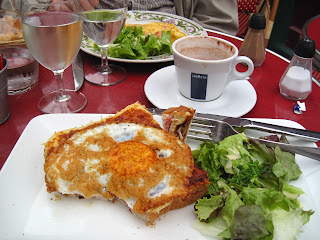Montmartre has such an interesting history but is mostly associated with the bohemian life of 19th century artists and scholars who were drawn to the area because it was outside the Paris city limits thus free of Paris taxes; and the local nuns made wine. By the end of the 19th century it was the center of decadent entertainment; the Moulin Rouge and Le Chat Noir became popular gathering places for artists, singers and performers. Many of the artists (Salvador Dali, Claude Monet, Auguste Renoir, Vincent Van Gogh, Pablo Picasso) had studios or worked around the community of Montmartre.
The Basilica of the Sacre Coeur was built (1877-1912) on top of the butte to honor the French victims of the Franco-Prussian War. The large white dome is a Paris landmark and can be seen for miles.
 |
| From Blvd. Haussman |
(For the more 'classic' view check out the link above.)
I used the funicular instead of the steps right next to it.
(At the bottom of these steps is a large place and from there it is another 2 blocks down to the Metro stop.) Just below to the right of the Basilica, artists set up easels amidst cafes and umbrellas on the Place du Tertre.
My goal for the day was Place Marcel Ayme, there is a very unusual sculpture there; so we headed towards Place du Tertre and Rue Norvins.
Place du Tertre is very commercial, lots of cafes, crowded and must be experienced. I really enjoy watching the artists, many of whom spend their time working on a piece of art. Rue Norvins borders by it.
Rue Norvins winds down and away from the Sacre Coeur.
It became quiet and quite beautiful. We began to see gardens behind fences and a very nice residential area.
We noticed the sign for this little park. It was left to go a bit wild but a nice little retreat nonetheless.
All of a sudden we came to this open area and there it was~ Le Passe-Muraille (The man who could walk through walls). Marcel Ayme (1902-1967) was a writer and published children's stories, novels and collections. One of his most famous short stories,The Walker Through Walls, inspired the sculpture created in 2006 by Jean-Bernard Metais.
From here we followed Rue Cortot to the Musee du Montmartre.
 |
| Rue Cortot |
 |
| Musee du Montmartre. |
Next to the Museum is the last vineyard in Paris. They do celebrate the harvest on the first Saturday in October, a festive event. (they say the wine is not that good.)
Since we walked down to get to our destination, the walk back was up...we chose the "scenic" route using Sacre Coeur as our compass.
This is Carmel de Montmartre, a Benedictine priory housing a community of nuns.
 |
| Romantic Rue Rustique |
We stopped for lunch at a restaurant on a lively intersection. I had a Croque Madame (grilled ham and cheese with an egg on top) and chocolat chaud~hot chocolate.
Right across from us was La Bonne Franquette. The sign said "Formerly, Aux Billiards en Bois, famous since 1890. It was a meeting place for many artists. It hosted Pissaro, Sisley, Degas, Cezanne, Renoir, Monet... The garden served as a model for Van Gogh's painting La Guinguette. It was painted in 1886 and is on view at the Louvre."
After lunch we made our way back to the funicular,
passing all the souvenir shops,
a wonderful (though hazy) view of the Eiffel Tower,
and in the place below Sacre Coeur~a surprise. A mime. Everyone was staring at her wondering if she was real. I love mimes, I dropped a coin in the hat and she came alive. The lady standing beside me jumped. The little red thing on her finger is a butterfly and when she moved her finger it looked like it was flying. She was really good.
Then down to the Metro, back to the apt to collapse until dinner.
It was really good day.



















No comments:
Post a Comment